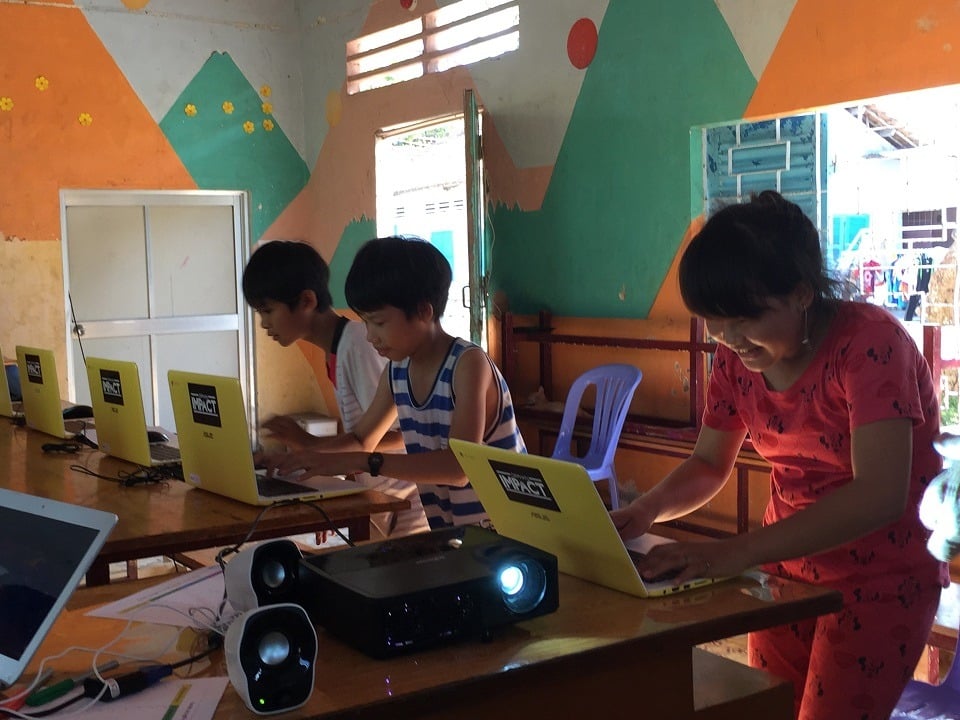
“Type and Move” at the Hoa Mai Orphanage
Photo Credit: Lauren Ziskie
Goal: Introduce Design Thinking to the Orphan Impact teachers’ repertoire, upgrade the program’s old laptops to new Chromebooks, and strengthen the organization’s career preparation curriculum.
Background: Stanford University’s d.school is considered one of the most innovative educational institutions out there, with its core philosophy of Design Thinking. As an undergraduate from Stanford’s Product Design program, I spent four years studying Design Thinking in the context of product design for both developed and developing markets. So, what does this Silicon-Valley-born methodology have to do with young kids from the Hoa Mai Orphanage in Can Tho, Vietnam? It turns out, a whole lot, thanks to the hard work of six Team4Tech volunteers and six Orphan Impact computer teachers.
Project: On day seven of Team4Tech’s two-week project with Orphan Impact, we arrived to the Hoa Mai Orphanage, a small, run-down, gated compound where the kids’ playful smiles were enough to light up the entire place. On this project, the orphanage received newly commissioned Chromebooks to replace Classmate PCs that had seen many years of sticky fingers and enthusiastic young users. Ngoc, one of Orphan Impact’s computer teachers, warmed up her class by having them dance to The Gummy Bear Song. The tense energy from having strange foreigners in their classroom was instantly replaced by uncontrollable giggling. Afterwards, the real work started. This was Ngoc’s first chance to practice teaching Design Thinking with one of her classes since our team of volunteers had introduced the concept five days earlier.
Just 45 minutes into observing the class, which was conducted in Vietnamese, I saw something truly remarkable. Ngoc was leading her class through a lesson about designing a better kite – it was the windy season in Vietnam, where the same mass-produced kites were for sale at every corner store. The class was practicing a brainstorming exercise that we had nicknamed “Type and Move.” Each student had one minute to type as many ideas as possible before the timer went off, and the students moved over to the next computer. Then, they had a chance to read through the list of ideas that their classmates had written before the next one-minute brainstorm timer started. I can’t understand five words of Vietnamese, but it was obvious that the kids were generating tons of ideas and having a blast doing it. However, the truly remarkable part was that observing the class evoked vivid memories of doing the exercise’s pen-and-paper equivalent, nicknamed “Write and Pass,” in the Stanford d.school years ago. How had two of my seemingly distant and opposite worlds come together so seamlessly? The kids in this orphanage were doing a higher-tech version of the same exercise that I had done at Stanford! I was simultaneously blown away, proud, and awestruck by the parallels between the past and present.
Team4Tech’s typical cascade model of “teaching the teachers” has a whole new meaning with the introduction of our Design Thinking programmatic content. The d.school faculty’s knowledge about Design Thinking was passed on from me, to the Team4Tech volunteers, to the Orphan Impact teaching staff, to the orphans in their program. Rather than using Design Thinking to create better products, we used it as a tool to foster collaborative problem solving skills. Simplifying the framework, overcoming language barriers, and working with younger students did nothing to detract from the quality of the educational outcome.
This moment was yet another proof point of the world’s incredible interconnectivity, allowing ideas and people to travel across yesterday’s boundaries. Our project volunteers drive these connections, so, as always, we invite you to apply to volunteer your skills and create more moments like these.